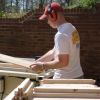It's currently a little over an inch thick, cut to a 43" diameter circle, and I'm in the process of smoothing it... without sandpaper.
I'm not a rich man, and ordered just enough walnut from Steve Wall to get the job done. Point being, I relied on visual appeal vs grain direction; so my grain doesn't all run in the same way. Not a big issue - my smoother takes a fine shaving and I can follow the joints pretty well.
My question is this - I've always sanded prefinish, and am trying to avoid that for this table. Folks talk about how nice a planed top looks - and as it's my wife's new walnut table, I'm hoping to achieve that.
Unfortunately, I've got some pretty gnarly grain that I'm dealing with - and am getting a bit of minor tearout in a few (errr several) spots. I can get a good burr on a scraper and shave the spots pretty well - but those spots (even when blended) look considerably different. The tracks of a scraper aren't nearly as pleasing as the tracks from a plane... and don't feel as smooth either...
I think I have the tools & skills to get there - just not sure how to apply them - or even what I'm trying to achieve... I assume it'd be best to avoid giving the whole thing light 220 going over (or heck, does it even matter that much?).
Thanks -
- jbd
* Using my Delta contractor's saw as a bench... if that matters...




 Reply With Quote
Reply With Quote



 )
)
